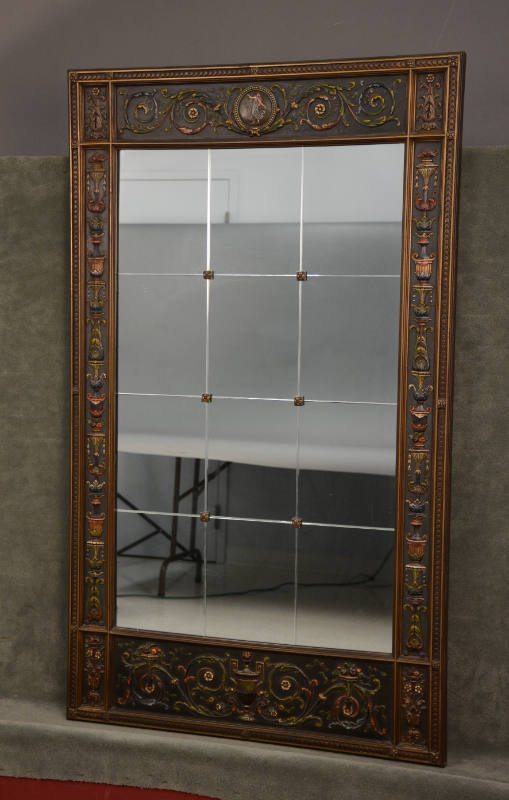Mirror, Wall
Object number2017.117.1
Designer
Joseph Horne Company
(1849 - 1994)
Date1960-1969
MediumWood; Paint; Glass; Metal; Paper; Adhesive
Credit LineGift of Jean L. Carver
DescriptionDecorative mirror. Rectangular wood border with shallow decorative relief; relief is painted in multiple colors; relief decorations include a dancing female figure at top center, numerous urns, and leafy scrollwork. Mirror is made up of twelve rectangular sections with beveled edges; each intersection has a square metal block with screw at center; blocks are carved on front. Reverse is covered in brown paper and has two metal eye-bolts with metal wire strung between for hanging. Reverse has metal staples along the edges.DimensionsHeight x Width x Depth: 54.188 × 32.125 × 2.125 in. (137.6 × 81.6 × 5.4 cm)Historical NotesThis mirror was used in an interior redesign of the H. Samson funeral home, likely sometime during the 1960s. The company employed the decorative services of Joseph Horne Company, which incorporated the mirror in its renderings. The mirror may have been purchased from Horne’s on this occasion, but the donor could not confirm this (many decorative objects in the Home were originally used in the family’s residence.) H. Samson, Inc. has administered to the funerals, burials and cremation needs of Pittsburghers for over 135 years. Founded in 1859 by Hudson Samson (1840-1903), the company remained in family control into the 1990s. Hudson Samson is recognized as an innovator in the field of mortuary science. He revolutionized the embalming process by inventing a fluid injecting-device, the “Samson Pump,” which negated the need for ice in the embalming and making it a portable and efficient procedure. This device allowed him to embalm, “on site” in the home of the deceased. Up to the late nineteenth century most funeral services were performed in the home of the deceased. Samson anticipated a change in this procedure and so he built one of the first all-in-one funeral homes in 1884 complete with chapel, another first. He also built the first crematory located within the business section of a large city. His facility was only the fifth crematory built in the country. In his services, Hudson Samson demanded a sense of style not often seen in this profession. He insisted on maintaining his own livery stable in which he kept only the finest horses. The lining for many of his caskets was from merino wool. Harry G.(1870-1948), Hudson’s son, took over as director after the death of his father in 1903. Harry also contributed the innovative nature of the Samson business by implementing the first motorized funeral vehicle, the auto hearse, in 1910. He is also credited with the coinage of the term, “mortician,” according to the American Funeral Director, 1959. Howard S. Samson ( -1974), son of Harry, assumed the leadership in 1948. He held that role until his death in 1974. Howard expanded the Samson business outside the city of Pittsburgh into suburban areas through extensive newspaper advertising and direct mailing of booklets describing Samson services. One of Howard’s most unusual concepts was the institution of the Provident Fund, into which individuals could deposit funds to provide for payment of funeral services at a later time. When Howard died in 1974 his wife, Elinor, became president of H. Samson, Inc. She remained at that position until her death in 1995. After Eleanor’s tenure, Samson was sold to CMS West, the largest funeral home operator in Western Pennsylvania. In March, 1997 the Loewen Group bought Samson from CMS West.
Previous owner
Howard S. Samson
Previous owner
H. Samson, Inc.
Previous owner
H. Samson Funeral Home
On View
Not on viewc. 1900
c. 1917
1953-1954













